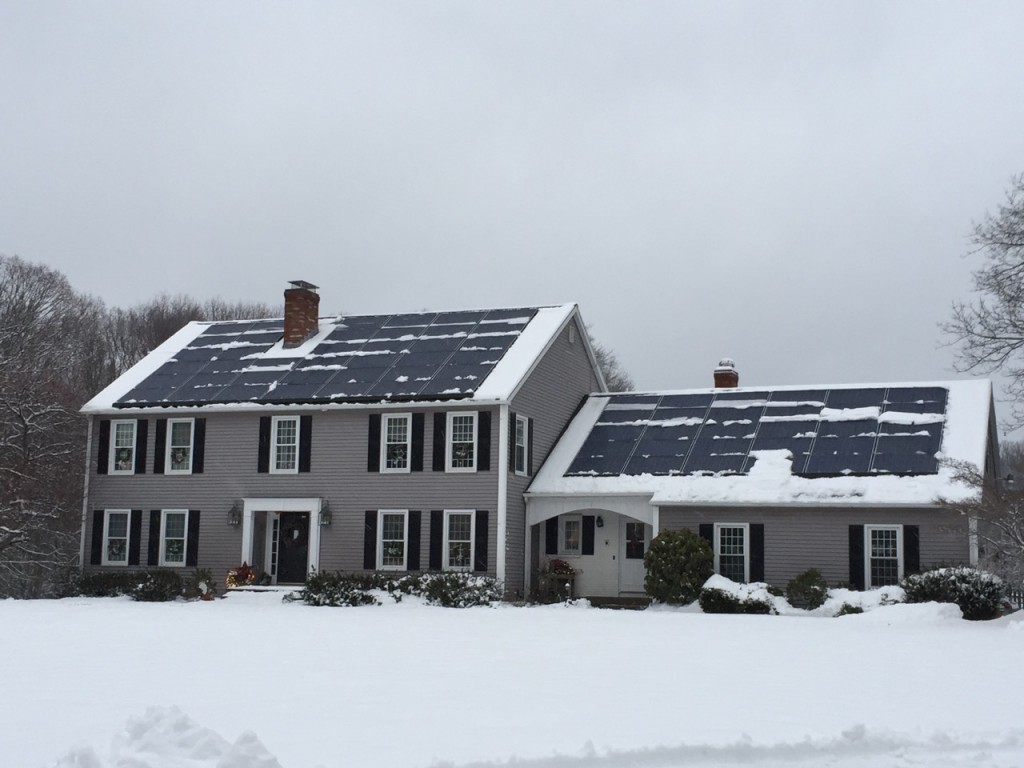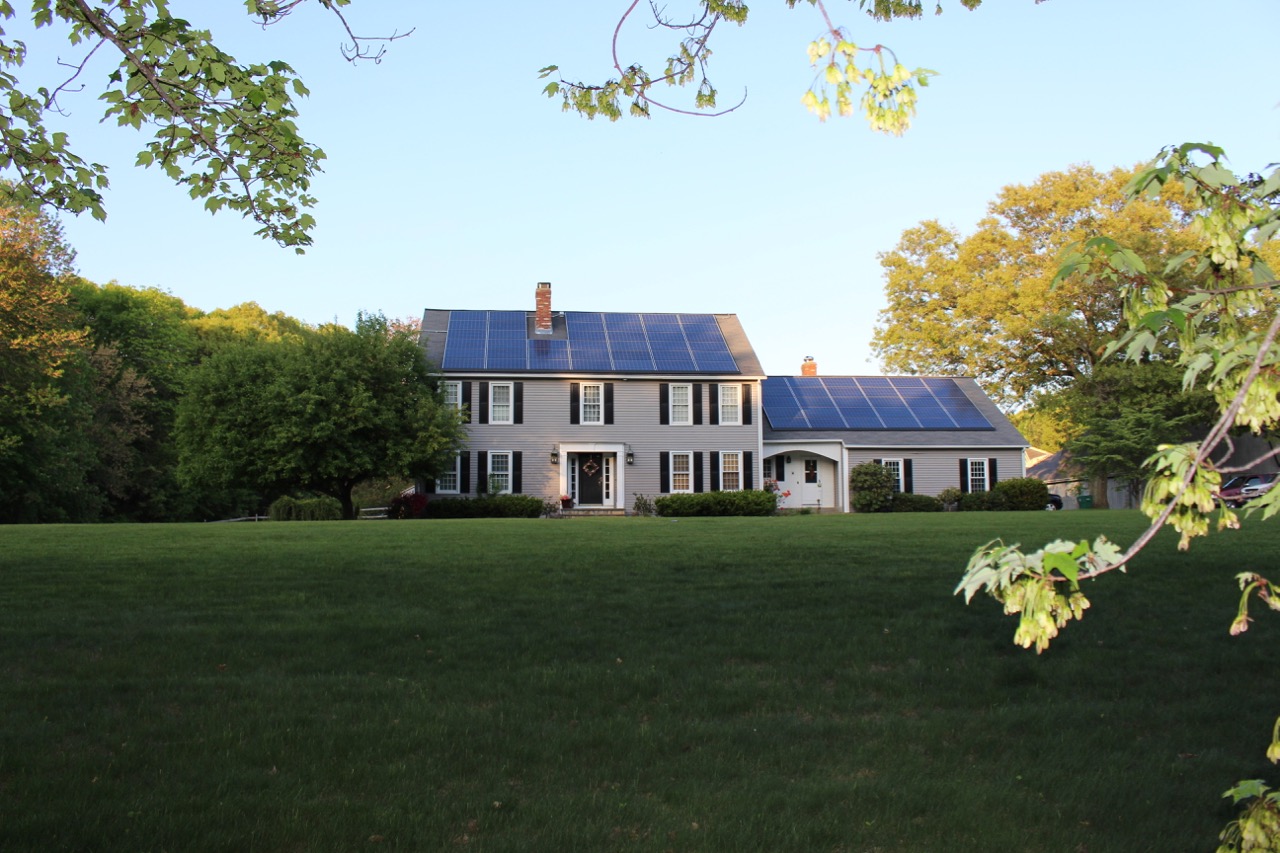

News
My journey with a SolarCity System: Snow, Net Metering
After 9 months of planning, waiting and negotiating, my SolarCity system installation was finally completed in December of 2014. Following the install, the only steps that remained were to implement updates required for net metering and to finalize the electrical and building inspections.
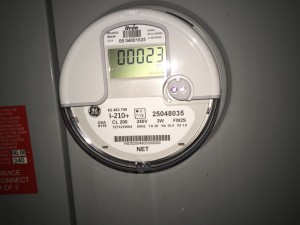
The electrical inspection went quickly, but the building inspection was a pain. The local building inspector wasn’t very responsive and scheduled inspections shortly after large snow storms, but then refused to do the inspection due to “snow covering the panels”.
While we waited for the inspections, which finally took place in March of 2015, National Grid installed a new Net Meter. Net meters are capable of monitoring the amount of power being sent back into the grid. The meter swap is quick work, but be forewarned that it requires power to be cut from your home during the swap.
Weathering the Storm
We had a brutal Winter here in the Northeast and this was my first year with panels. So I had concerns about the impact of the heavy snow being on top of the panels, and also how one goes about cleaning off the snow. I asked SolarCity about proper handling and they told me not to worry about it:
“We understand your concern with the snow and the load that it would cause. Please be advised that when your system was built, our engineers took into consideration, your roof structure as well as the amount of weight that it would be able to hold. We also have the system approved by the City for load bearings.The City and our engineers did take into consideration, the amount of largest amount of snow that your roof can withstand before we installed. I understand that there was a mass message out to all the people in the area advising them to make sure that they clear the roof. We advised that you allow the snow to melt/slide down on its own., If you are hiring someone to come out to clear the roof. Make sure that they be careful and they only sweep the panels.”
I patiently waited for the snow to slide off the panels and sure enough it did, and with no issues. The snow slides off the black, wet glass-like surface of the solar panels. You definitely don’t want to be anywhere below the roofline when the snow decides to let go!
Early Issues – Broken Gear
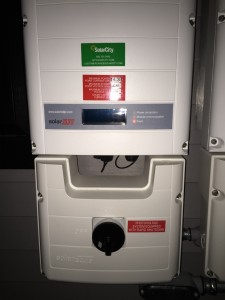 Once National Grid completed the net metering install, I was finally approved to turn on the system. The first step involves turning a big dial (on each inverter) from off to on. I have three inverters which means three dials to flip on.
Once National Grid completed the net metering install, I was finally approved to turn on the system. The first step involves turning a big dial (on each inverter) from off to on. I have three inverters which means three dials to flip on.
I turned each of them on. Two lit green almost immediately while the remaining inverted displayed a red fault light. There were no instructions on what to do in this scenario; no manuals and no guidance, so my only option was to call for help.
Getting help from SolarCity on the issue at had was a frustrating experience. SolarCity has a lot to learn when it comes to customer service. I spoke to several customer support managers as I continued to escalate my issue.
Finally, after five weeks of follow ups and many phone calls, I got the broken inverter fixed.
Tip:
SolarCity doesn’t bother to tell you this, but what I discovered was a little black button in the middle of the inverter. It’s hard to see but if you press the button you’ll be able to cycle through messages on the digital display, one of which is a fault code. Providing SolarCity with a fault code is much more useful than just letting them know that a red light is blinking.
Early Issues – Snow Fall
As mentioned earlier, snow doesn’t stick to the panels for long, but it does manage to build up before it lets go. Imagine 3 feet of heavy snow mixed with ice over your entire roof all letting go at the same time. It’s not a slow drip. It’s an avalanche.
The end result is dead flowers, dead bushes, and broken branches on vegetation immediately below the roof. As much as it’s common sense that snow will eventually melt from a roof and slide down, I wish SolarCity would have warned us that snow tends to slide from solar panels at a much quicker rate. I would have done something to fortify those flowers and bushes. After all, landscaping is not cheap.
There’s an accident waiting to happen so I think it’s in SolarCity’s best interest to pre-warn people of this, especially newbies to the world of solar panels.
Summary
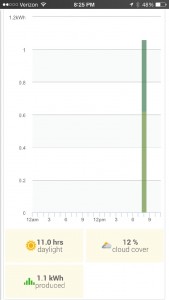 Eleven months after starting the project, my SolarCity system finally went live (partially) on February 23, 2015. And on April 1, 2015, the third inverter was fixed allowing the system to work in its full capacity.
Eleven months after starting the project, my SolarCity system finally went live (partially) on February 23, 2015. And on April 1, 2015, the third inverter was fixed allowing the system to work in its full capacity.
The image to the right is showing the day when the transformer on my street blew up and the entire street lost power for several hours. I added 33% more power from my large system going back into the network while using very little (Winter time) the same day the transformer blew. But then again, it was also April 1. Nobody made a fuss — National Grid replaced the transformer and all has been stable since. My best guess as to why that happened? Perhaps the transformer was already near its thresholds and my solar installation was the one to tip it over?
I’ll be writing about system monitoring, cost savings and billing errors in upcoming posts. The story isn’t over yet.

Elon Musk
Starlink passes 9 million active customers just weeks after hitting 8 million
The milestone highlights the accelerating growth of Starlink, which has now been adding over 20,000 new users per day.

SpaceX’s Starlink satellite internet service has continued its rapid global expansion, surpassing 9 million active customers just weeks after crossing the 8 million mark.
The milestone highlights the accelerating growth of Starlink, which has now been adding over 20,000 new users per day.
9 million customers
In a post on X, SpaceX stated that Starlink now serves over 9 million active users across 155 countries, territories, and markets. The company reached 8 million customers in early November, meaning it added roughly 1 million subscribers in under seven weeks, or about 21,275 new users on average per day.
“Starlink is connecting more than 9M active customers with high-speed internet across 155 countries, territories, and many other markets,” Starlink wrote in a post on its official X account. SpaceX President Gwynne Shotwell also celebrated the milestone on X. “A huge thank you to all of our customers and congrats to the Starlink team for such an incredible product,” she wrote.
That growth rate reflects both rising demand for broadband in underserved regions and Starlink’s expanding satellite constellation, which now includes more than 9,000 low-Earth-orbit satellites designed to deliver high-speed, low-latency internet worldwide.
Starlink’s momentum
Starlink’s momentum has been building up. SpaceX reported 4.6 million Starlink customers in December 2024, followed by 7 million by August 2025, and 8 million customers in November. Independent data also suggests Starlink usage is rising sharply, with Cloudflare reporting that global web traffic from Starlink users more than doubled in 2025, as noted in an Insider report.
Starlink’s momentum is increasingly tied to SpaceX’s broader financial outlook. Elon Musk has said the satellite network is “by far” the company’s largest revenue driver, and reports suggest SpaceX may be positioning itself for an initial public offering as soon as next year, with valuations estimated as high as $1.5 trillion. Musk has also suggested in the past that Starlink could have its own IPO in the future.
News
NVIDIA Director of Robotics: Tesla FSD v14 is the first AI to pass the “Physical Turing Test”
After testing FSD v14, Fan stated that his experience with FSD felt magical at first, but it soon started to feel like a routine.

NVIDIA Director of Robotics Jim Fan has praised Tesla’s Full Self-Driving (Supervised) v14 as the first AI to pass what he described as a “Physical Turing Test.”
After testing FSD v14, Fan stated that his experience with FSD felt magical at first, but it soon started to feel like a routine. And just like smartphones today, removing it now would “actively hurt.”
Jim Fan’s hands-on FSD v14 impressions
Fan, a leading researcher in embodied AI who is currently solving Physical AI at NVIDIA and spearheading the company’s Project GR00T initiative, noted that he actually was late to the Tesla game. He was, however, one of the first to try out FSD v14.
“I was very late to own a Tesla but among the earliest to try out FSD v14. It’s perhaps the first time I experience an AI that passes the Physical Turing Test: after a long day at work, you press a button, lay back, and couldn’t tell if a neural net or a human drove you home,” Fan wrote in a post on X.
Fan added: “Despite knowing exactly how robot learning works, I still find it magical watching the steering wheel turn by itself. First it feels surreal, next it becomes routine. Then, like the smartphone, taking it away actively hurts. This is how humanity gets rewired and glued to god-like technologies.”
The Physical Turing Test
The original Turing Test was conceived by Alan Turing in 1950, and it was aimed at determining if a machine could exhibit behavior that is equivalent to or indistinguishable from a human. By focusing on text-based conversations, the original Turing Test set a high bar for natural language processing and machine learning.
This test has been passed by today’s large language models. However, the capability to converse in a humanlike manner is a completely different challenge from performing real-world problem-solving or physical interactions. Thus, Fan introduced the Physical Turing Test, which challenges AI systems to demonstrate intelligence through physical actions.
Based on Fan’s comments, Tesla has demonstrated these intelligent physical actions with FSD v14. Elon Musk agreed with the NVIDIA executive, stating in a post on X that with FSD v14, “you can sense the sentience maturing.” Musk also praised Tesla AI, calling it the best “real-world AI” today.
News
Tesla AI team burns the Christmas midnight oil by releasing FSD v14.2.2.1
The update was released just a day after FSD v14.2.2 started rolling out to customers.

Tesla is burning the midnight oil this Christmas, with the Tesla AI team quietly rolling out Full Self-Driving (Supervised) v14.2.2.1 just a day after FSD v14.2.2 started rolling out to customers.
Tesla owner shares insights on FSD v14.2.2.1
Longtime Tesla owner and FSD tester @BLKMDL3 shared some insights following several drives with FSD v14.2.2.1 in rainy Los Angeles conditions with standing water and faded lane lines. He reported zero steering hesitation or stutter, confident lane changes, and maneuvers executed with precision that evoked the performance of Tesla’s driverless Robotaxis in Austin.
Parking performance impressed, with most spots nailed perfectly, including tight, sharp turns, in single attempts without shaky steering. One minor offset happened only due to another vehicle that was parked over the line, which FSD accommodated by a few extra inches. In rain that typically erases road markings, FSD visualized lanes and turn lines better than humans, positioning itself flawlessly when entering new streets as well.
“Took it up a dark, wet, and twisty canyon road up and down the hill tonight and it went very well as to be expected. Stayed centered in the lane, kept speed well and gives a confidence inspiring steering feel where it handles these curvy roads better than the majority of human drivers,” the Tesla owner wrote in a post on X.
Tesla’s FSD v14.2.2 update
Just a day before FSD v14.2.2.1’s release, Tesla rolled out FSD v14.2.2, which was focused on smoother real-world performance, better obstacle awareness, and precise end-of-trip routing. According to the update’s release notes, FSD v14.2.2 upgrades the vision encoder neural network with higher resolution features, enhancing detection of emergency vehicles, road obstacles, and human gestures.
New Arrival Options also allowed users to select preferred drop-off styles, such as Parking Lot, Street, Driveway, Parking Garage, or Curbside, with the navigation pin automatically adjusting to the ideal spot. Other refinements include pulling over for emergency vehicles, real-time vision-based detours for blocked roads, improved gate and debris handling, and Speed Profiles for customized driving styles.
